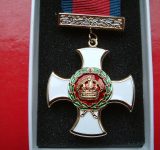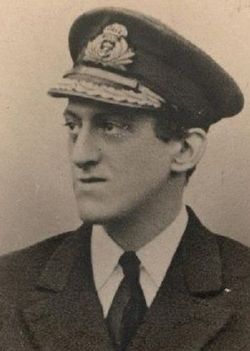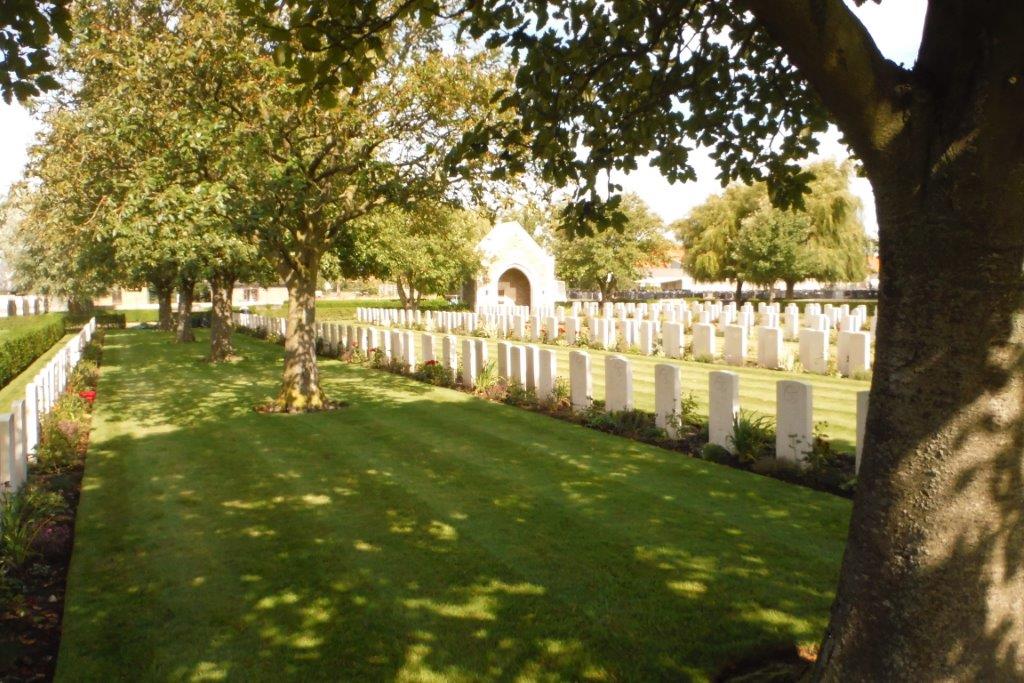Personal Details
Alfred Edmund Godsal was born in Sturminster Marshall, Dorset on 2nd December 1884 (baptised 28th December 1884), the fourth son of Major Philip Thomas and Mrs Ellen Henrietta Godsal of Iscoyd Park, Whitchurch, Shropshire.
Alfred attended HMS Britannia, the Royal Naval College in Dartmouth, Devon, where he graduated with firsts in the five subject study areas.
Alfred’s wartime exploits are well documented and were drawn to conclusion in Ostend. He was serving on HMS Brilliant in April 1918 and was involved in the first Ostend blockships exercise to stop enemy U-boats getting out of the port. The ship came under a tremendous barrage of enemy fire from shore batteries, and unfortunately the exercise was a failure. Nonetheless, it was reported that Commander Godsal’s bearing and spirits had been very gallant. On 10th May 1918 another attempt was made to block the entrance to the port of Ostend, and again Commander Godsal was involved. This time the aim was to sink the ship HMS Vindictive (commanded by Commander Godsal) in the channel, but again, despite these drastic measures, U-boats still found a way through. It was during the resultant heavy fighting that Commander Godsal was killed by a shell.
His brother, Major Walter Hugh Godsal, also lost his life in the Great War.
Military Details
Regiment : HMS Vindictive, Royal Navy
Rank : Commander
Service Number :
Killed in action; Belgium 10 May 1918 Aged 33

The Distinguished Service Order (DSO) is a military decoration of the United Kingdom, and formerly of other parts of the Commonwealth of Nations, awarded for meritorious or distinguished service by officers of the armed forces during wartime, typically in actual combat.
Instituted on 6 September 1886 by Queen Victoria in a Royal Warrant published in The London Gazette on 9 November, the first DSOs awarded were dated 25 November 1886. It is typically awarded to officers ranked major (or its equivalent) or higher, but the honour has sometimes been awarded to especially valorous junior officers. During the First World War, 8,981 DSOs were awarded, each award being announced in The London Gazette.
The order was established for rewarding individual instances of meritorious or distinguished service in war. It was a military order, until recently for officers only, and normally given for service under fire or under conditions equivalent to service in actual combat with the enemy, although it was awarded between 1914 and 1916 under circumstances which could not be regarded as under fire (often to staff officers, which caused resentment among front-line officers). After 1 January 1917, commanders in the field were instructed to recommend this award only for those serving under fire. Prior to 1943, the order could be given only to someone mentioned in despatches. The order is generally given to officers in command, above the rank of captain. A number of more junior officers were awarded the DSO, and this was often regarded as an acknowledgement that the officer had only just missed out on the award of the Victoria Cross. In 1942, the award of the DSO was extended to officers of the Merchant Navy who had performed acts of gallantry while under enemy attack.

The 1914 Star (also known as 'Pip') was authorised under Special Army Order no. 350 in November 1917 and by an Admiralty Fleet Order in 1918, for award to officers and men of the British and Indian Expeditionary Forces who served in France or Belgium between 5 August and midnight of 22–23 November 1914. The former date is the day after Britain's declaration of war against the Central Powers, and the closing date marks the end of the First Battle of Ypres.
The 1914–15 Star (also known as 'Pip') was instituted in December 1918 and was awarded to officers and men of British and Imperial forces who served against the Central European Powers in any theatre of the Great War between 5 August 1914 and 31 December 1915. The period of eligibility was prior to the introduction of the Military Service Act 1916, which instituted conscription in Britain.
The British War Medal (also known as 'Squeak') was a silver or bronze medal awarded to officers and men of the British and Imperial Forces who either entered a theatre of war or entered service overseas between 5th August 1914 and 11th November 1918 inclusive. This was later extended to services in Russia, Siberia and some other areas in 1919 and 1920. Approximately 6.5 million British War Medals were issued. Approximately 6.4 million of these were the silver versions of this medal. Around 110,000 of a bronze version were issued mainly to Chinese, Maltese and Indian Labour Corps. The front (obv or obverse) of the medal depicts the head of George V. The recipient's service number, rank, name and unit was impressed on the rim.
The Allied Victory Medal (also known as 'Wilfred') was issued by each of the allies. It was decided that each of the allies should each issue their own bronze victory medal with a similar design, similar equivalent wording and identical ribbon. The British medal was designed by W. McMillan. The front depicts a winged classical figure representing victory. Approximately 5.7 million victory medals were issued. Interestingly, eligibility for this medal was more restrictive and not everyone who received the British War Medal ('Squeak') also received the Victory Medal ('Wilfred'). However, in general, all recipients of 'Wilfred' also received 'Squeak' and all recipients of The 1914 Star or The 1914/1915 Star (also known as 'Pip') also received both 'Squeak' and 'Wilfred'. The recipient's service number, rank, name and unit was impressed on the rim.
Further Information
Report in the Faringdon Advertiser 18 May 1918 regarding the death of Alfred Edmund Godsal
"HEROES OF OSTEND RAID. THE VINDICTIVE'S OFFICERS.
Official sanction has now been given to the publication of the names of the gallant officers who were in charge of the Vindictive in the hazardous operations at Ostend on Friday morning last week. Commander A. E. Godsal was in command of the old cruiser, and with Lieutenant Sir John Alleyne and Lieutenant Crutchley stationed himself at the upper steering position.When the vessel was approaching the harbour mouth the fire from the shore was so heavy that the three officers took shelter in the conning-tower. After swinging the ship into the channel and ramming her stern against the eastern pier, Commander Godsal left the protection of the conning-tower and went outside in order the better to see the position of the vessel. A shell burst outside the conning-tower, and, it is believed , killed the gallant officer.
The command then devolved upon Lieutenant Crutchley, who, after ascertaining that the Vindictive would not turn any further, cleared the engine-room and stoke-hole and blew the charges. The crew jumped into two motor-boats - 254 (Lieutenant Drummond, R.N.V.R.) and 276 (Lieutenant Bourke, R.N.V.R.) - which had gallantly stood by to rescue the men. One of the motor-boats, with Lieutenant Crutchley, Engineer-Commander W. A. Bury, and thirty-eight men of the Vindictive, was sighted by Admiral Keyes' flagship Warwick, which took the party on board. Motor-launch 276 brought off Lieutenant Sir John Alleyne and two ratings. Two other motor-launches - 383 (Lieutenant-Commander Hoare) and 128 (Lieutenant Saunders, R.N.V.R.) - were also detailed for rescue work, and searched the shores carefully under heavy fire.
Engineer-Commander Bury was on the Vindictive in the Zeebrugge attack, and Lieutenant Crutchley and Sub-Lieutenant A. H. Maclachlan were aboard the Brilliant on that occasion. Lieutenant Maclachlan is missing, and is believed to have fallen in Friday's operations.
A COMPLETE SURPRISE. HOW VINDICTIVE CARRIED OUT HER MISSION.
A supplementary account of the enterprise has been given in a report supplied by the Admiralty and dated from Dunkirk. This account says:There was no preliminary bombardment of the harbour and the batteries, as before the previous attempt: that was to be the first element in the surprise. The Vindictive, having found the flagship's light-buoy that was to be her guide, bore up for where a coastal motor-boat, commanded by Lieutenant William R. Slayter, R.N., was waiting by a calcium flare upon the old position of the Stroom Bank buoy. Four minutes before she arrived there, and fifteen minutes only before she was due at the harbour mouth, the signal for the guns to open was given.
Two motor-boats, under Lieutenant Darrel Reid, R.N.R., and Lieutenant Albert L. Poland, R.N., dashed in towards the ends of the high wooden piers and torpedoed them, the monitors opened fire, the aeroplanes dropped the first bombs, and upon the warning of the explosions the enemy guns came into action.
VINDICTIVE LOSES HER WAY.
The uproar and blaze of conflict was now tremendous, and through it all the old Vindictive walked the lighted waters towards the entrance. It was then that those on the destroyers became aware that a sea fog had come on. The destroyers had to turn on their lights and use their syrens to keep in touch with each other; the air attack was suspended, and the Vindictive, with some distance yet to go, found herself in gross darkness.There were motor-boats to either side of her escorting her to the entrance, and these were supplied with what are called Dover flares - enormous lights capable of illuminating square miles of sea at once. A Verey pistol was fired as a signal to light these, but the fog and smoke together were too dense for even the flares. The Vindictive there[fore] put her helm over and started to cruise to find the entrance. Twice she must have passed across it, and at her third turn, upon reaching the position at which she had first lost her way, there came a rift in the mist and she saw the entrance clear, the piers to either side and the opening dead ahead. The inevitable motor-boat dashed up (No.22, commanded by Acting-Lieutenant Guy L. Cockburn, R. N. ), raced on into the opening under a heavy and momentarily growing fire, and planted a flare on the water between the piers. The Vindictive steamed over it. She was hit every few seconds after she entered."
Faringdon Advertiser 18 May 1918
Report in the Llangollen Advertiser 24 May 1918 regarding the death of Alfred Edmund Godsal
"THE STORY OF OSTEND. HOW COMMANDER GODSAL FELL.
The Admiralty, on Wednesday, issued an official account of the exploit, in the course of which it was described how Commander Godsal, who was in Command of the "Vindictive" in her hazardous venture to block the fairway of Ostend Harbour, met his death.The guns found her at once. She was hit every few seconds after she entered, her scarred hull broken afresh in a score of places and her decks and upper works swept. The machine-gun on the end of the western pier had been put out of action by the motorboat's torpedo, but from other machine guns at the inshore ends of the pier, from a position on the front, and from machine-guns apparently firing over the eastern pier, there converged upon her a hail of lead. The after control was demolished by a shell which killed all its occupants, including Sub-Lieutenant Angus H. MacLachlan, who was in command of it. Upper and lower bridges and chart room were swept by bullets, and Commander Godsal, R.N., ordered his officers to go with him to the conning tower. They observed through the observation slit in the steel wall of the conning tower that the eastern pier was breached some 200 yards from its seaward end, and as though at some time a ship had been in collision with it. They saw the front of the town silhouetted again and again in the light of the guns that blazed at them; the night was a patchwork of fire and darkness. Immediately after passing the breach in the pier, Commander Godsal left the conning tower and went out on deck, the better to watch the ship's movements; he chose his position, and called in through the slit of the conning tower his order to starboard the helm. The Vindictive responded; she laid her battered nose to the eastern pier and prepared to swing her 320 ft. length across the channel.
COMMANDER GODSAL'S DEATH
It was at that moment that a shell from the shore batteries struck the conning tower. Lieut. Sir John Alleyne and Lieut. V. A. Crutchley were still within. Commander Godsal was close to the tower outside. Lieut. Alleyne was stunned by the shock. Lieut. Crutchley shouted through the slit to the commander, and, receiving no answer, rang the port engine full speed astern to help in swinging the ship. By this time she was lying at an angle of about 40 deg to the pier, and seemed to be hard and fast, so that it was impossible to bring her further round. After working the engines for some minutes to no effect, Lieut. Crutchley gave an order to clear the engine-room and abandon ship according to the programme previously laid down. Engineer Lieut.-Commander William A. Bury, who was last to leave the engine room, blew the main charges by the switch installed aft; Lieut. Crutchley blew the auxiliary charges in the forward 6 in. magazine from the conning tower. Those on board felt the old ship shrug as the explosive tore the bottom plates and the bulk heads from her; she sank about 6 ft. and lay on the bottom of the channel. Her work was done.It is to be presumed that Commander Godsal was killed by the shell which struck the conning tower. Lieut. Crutchley, searching the ship before he left her, failed to find the body, or that of Sub-Lieut. MacLachlan, in that wilderness of splintered wood and shattered steel. In the previous attempt to block the port, Commander Godsal had commanded the Brilliant, and, together with all the officers of that ship and of the Sirius had volunteered at once for a further operation.
COMMANDER GODSAL'S CAREER
Commander Alfred Edmund Godsal, R.N., was the fourth son of Major and Mrs. Godsal of Iscoyd Park, Whitchurch. Born in 1884, he was educated at A. J. de Winton's, Slough and from thence passed into H.M.S. Britannia, from which he passed with five firsts, and in the language of the fleet, he was a "five wonner". His first ship was the Hannibal, in which the senior midshipman was the son of Mr. Robinson, of Frankton. Commander Godsal had completed over seventeen years in the navy, and had spent commissions in the West Indies, China and Mediterranean Seas, in the Hogue, Monmouth, and Irresistible respectively, before taking the torpedo course at Portsmouth, and the advanced course of wireless telegraphy at Chatham. While serving in the Monmouth on the China Station he commanded the despatch boat, Kinsha. His chief service was in the Centurion, to which he was appointed as torpedo-lieutenant in November, 1912, and he remained in her after his promotion to commander last midsummer. He left the Centurion to serve under his old captain, now Vice-Admiral Sir Roger Keys. He volunteered for service in the attempt made on Zeebrugge, and in Brilliant he was the leader of the Ostend operations, which, through no fault of hi,s were not successful. He came through this trying ordeal with a slight wound, and again volunteering for the second attempt on Ostend, he was given the command of the Vindictive.The French Croix de Guerre has been conferred on Commander Godsal, and had he lived it is understood he would have been promoted to captain and have had the D.S.O. awarded him."
Llangollen Advertiser 24 May 1918
Taken from Forces War Records
More information about Alfred Edmund Godsal is available from his naval records at Cymru 1914 , from Sturminster Marshall Village History Archive here and here, from Flintshire War Memorials and from Wikipedia.
If you can provide any further information on Alfred Edmund Godsal please get in touch by leaving a comment below, using our Contact Form or by calling in to Whitchurch Heritage Centre.
Information provided by Whitchurch Museum and Archives


